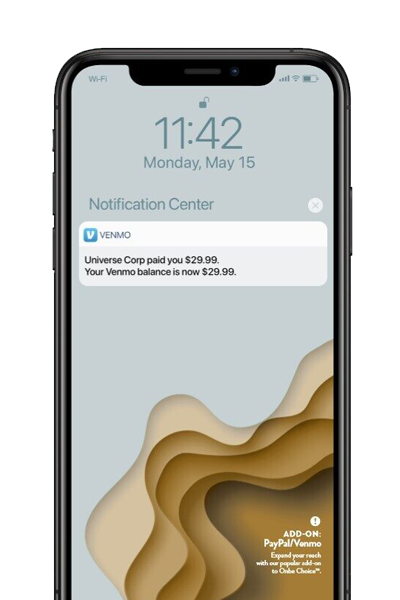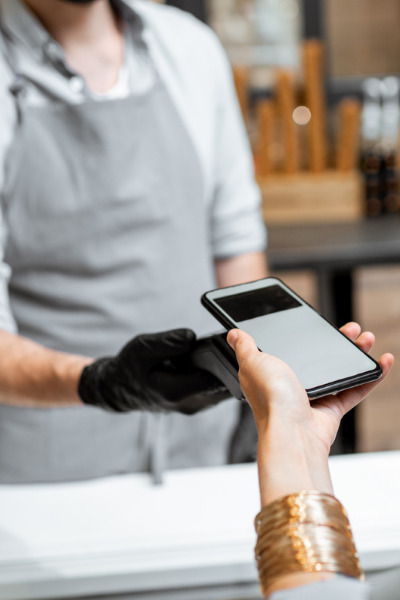Text
With the housing and rental markets undergoing dramatic changes in recent years, tenants are on the move—and whether they’re downsizing, upgrading, or trading apartment life for homeownership, they expect to be reimbursed for their security deposit quickly and efficiently.

0 notes
Text
Building Better Payment Experiences Helps Companies Navigate The “Great Reshuffle”

Building a company for where the world is going requires organizations to align with how their customers and workforces want to be paid: through experiences that are immediate, personalized, and inclusive of each recipient’s preferred payment modality and spend channel.
0 notes
Text
Onbe makes it easy to deliver custom-branded, engaging payment experiences with the choices businesses and consumers expect.

This guide showcases Onbe's array of solutions, presenting a spectrum of payment choices to cater to diverse needs and preferences. From traditional payment methods to innovative digital options, the guide illuminates the breadth and versatility of Onbe's payment solutions.
0 notes
Text
Onbe sees every payment as an opportunity to make an impression, capture data, and spark dialogue, connecting businesses and their constituents across the globe in meaningful ways.

Kicking off a new blog is always exciting, and I’m honored to author Onbe’s inaugural post in what promises to be a dynamic forum for thought leadership from experts across our organization. This moment is especially important to me because it’s a chance to take stock after the whirlwind of the past few months: building and launching a powerful new brand positioned to lead within the ever-transforming payments industry.
The convergence of marketing and payments is in my DNA. I got my start in payments in 1999 at Parago, and I still remember the first rebate check I signed by hand. Early in my career, I saw the opportunities open-loop payment cards could deliver, including custom branding, added convenience for the recipient, and insights that help brands learn about their customers. Payments have come a long way since then, with a growing focus on digital to thank for the innovations modern businesses have at their fingertips—like virtual payments that deliver funds into recipients’ hands in seconds.
When I tell the story of Onbe, the word “serendipitous” comes to mind. Not to downplay all that goes into envisioning and launching a new brand, but there was something special in the air when the opportunity arose to merge two industry leaders, daVinci Payments and North Lane Technologies, and create a unified payments technology company. The right people connected at the right time. The perfect mix of products, expertise, and passion came together to become something bigger than the sum of those parts.
Learn more: https://www.onbe.com/post/meet-onbe-your-payments-provider
0 notes
Text
How Healthcare Organizations Can Evolve Their Payment Strategy And Improve Recipient Satisfaction
Patient refunds are on the rise, and healthcare payers and providers should do their part to ensure the experience goes smoothly. Offering digital payment options alongside checks is not only more expedient and cost-effective but provides a better customer experience and helps to reduce the instances of unclaimed funds.
By: Tony McGee, Senior Director, Market Management
Going to the doctor (and paying for it) can be a stressful experience. So, when patients are owed a payment—whether it’s a medical refund, Medical Loss Ratio (MLR) rebate, or wellness incentive—healthcare payers and providers should do their part to ensure the experience goes smoothly.
For most consumers, smooth means digital. According to McKinsey & Company, 89 percent of Americans use digital payments, and they seek new ways that modern payment options can make their lives easier. By adopting digital-first solutions for making payments at scale, healthcare organizations can streamline their back-of-house payment processes while delivering faster, more convenient and secure recipient experiences.
Improving the Healthcare Refund Experience
Patient refunds are on the rise, totaling $3.1 billion in 2022. The biggest reason is that healthcare billing is fraught with complexity, making errors commonplace. If healthcare organizations incorrectly estimate the patient’s responsibility, they must provide a refund following the insurer’s adjustment.
But for many healthcare organizations, the medical refund process creates even more room for error. 74 percent of patient refunds are sent by check, according to advisory group Aite-Novarica. Checks can cause friction for recipients if the payment is delivered to the wrong address, lost or stolen, or if the recipient is unbanked. For organizations, checks are an especially costly way to issue a high volume of payments, with each costing anywhere from $3 to 12 dollars when all expenses—from administrative labor to postage—are factored in. And if recipients don’t cash their refunds, the healthcare organization is responsible for escheatment, the process of turning over unclaimed property to the state.
Offering digital payment options alongside checks is not only more expedient and cost-effective but provides a better customer experience and helps to reduce the instances of unclaimed funds. Going digital is also a chance to curtail check fraud, which leads to billions in losses every year. 63 percent of consumers believe digital payments are more secure, according to Onbe’s 2023 Future of Payments survey. Providing choices such as virtual or physical prepaid cards, push to debit—and, yes, traditional checks or ACH for those who want them—lets patients choose the refund method that works best for them.
Encouraging New Behaviors with Wellness Incentives
With healthcare costs on the rise, driving healthier behavior—whether it’s scheduling an annual wellness checkup, getting vaccinated, or exercising more—has become a priority for everyone from healthcare payers to public health organizations. In 2022, less than half of large firms offering health and wellness programs said their programs were effective at improving the health and well-being of enrollees, according to the Kaiser Family Foundation. But just 40 percent of large firms paid workers an incentive to encourage healthy behaviors, suggesting that more could be done to help program participants prioritize their health.
Findings on the role of incentives in health plans suggest that not only are rewards crucial to improving healthcare outcomes, but they work best when they offer value beyond the dollar value of the incentive. That includes letting recipients “shop” for their preferred incentive choice. When organizations ranging from employers to healthcare payers want to encourage healthy behaviors, creating incentive experiences that offer payment choice, instant gratification, and a seamless, digital-first experience could help improve participant engagement and retention. Especially now that many consumers prefer to use payment apps and mobile wallets, adding more options for participants to access and spend their incentives could help drive program success.
Overcoming Barriers to Payment Choice
When handling billing and collections, most healthcare organizations are equipped to accept digital payments. But when paying patients and customers, these same organizations typically lack the technology and infrastructure they need to meet diverse payment preferences. That’s where partnering with a fintech can help with the heavy lifting. By partnering with a payments expert, healthcare organizations can offer a better experience for recipients while removing the burden from back-office staff. They can save money on check processing, hand off the risk and responsibility of managing unclaimed property, and reduce the risk of payment fraud by taking advantage of the latest intelligent monitoring solutions in the industry. And they can deliver innovative payment experiences that increase recipient satisfaction, drive healthy behaviors, and give recipients the power to choose their preferred payment method.
The healthcare landscape is unlikely to become less complex anytime soon. But partnering with a fintech that specializes in handling payouts can help to simplify one piece of the puzzle: delivering positive payment experiences for both your recipients and your team.
To learn more, view our fact sheet, 5 Things to Know About Patient Refunds.
Original Source: https://www.onbe.com/post/how-healthcare-orgs-can-evolve-their-payment-strategy-and-improve-recipient-satisfaction
Source: onbe.com
0 notes
Text
Optimizing Business Through Payment Efficiency, Part 2: Unlocking Time & Cost Savings By Partnering With A Payments Fintech
While economic uncertainty can be worrying, times of change bring the chance to innovate, optimize your business processes, and discover new sources of revenue. If your business routinely makes disbursements to customers and workers, upgrading your payment strategy is an opportunity you might not have considered.
In part two of this series, the Onbe editorial team spoke with Damien Glista, Vice President of Relationship Management and Sales at Onbe, to glean insights from his 16 years in the payments industry. Glista shared ways that adopting modern, digital-first payment solutions can save time and labor, unlock cost savings, and reduce risk while improving the payee experience.
The High Cost of Check Processing
For most businesses, making a payment means cutting a check. While it sounds simple, issuing paper checks becomes complex and costly when a high volume of payments is involved—think consumer refunds, rebates, or salesperson incentives. “Check processing is a big job for accounts payable teams,” Glista explained. “Then, since not every recipient will cash their check, staff end up spending many more hours either resending checks or filing unclaimed property reports.”
Paper checks don’t just mean an administrative hassle; they can result in steep costs for payers, generally in the range of $3-12 per check. “You have to factor in not only the cost of paper and postage, but the expense of dealing with checks that weren’t cashed,” said Glista. “Each state has different rules and regulations for handling unclaimed property, and getting it wrong could lead to steep fines. Many businesses don’t realize how much they could save by switching to a third-party payment solution.”
Partnering with a payments fintech lets businesses hand over or automate most of the administrative labor involved in managing payment programs, plus gain access to more efficient payment solutions, such as virtual cards. “You not only can reduce the work involved in making and reconciling payments, but you can switch to faster, digital and electronic payment methods that eliminate the costs of printing and delivery,” said Glista.
Fraud Management: A Steep Administrative Burden
Working with a payments partner can also eliminate the burden of handling fraud—and help reduce fraud activity through a proactive approach. 63% of organizations reported check fraud in 2022, according to the Association for Financial Professionals (AFP). “Whenever fraud occurs, your team needs to void and reissue the check, alert the bank, and file a claim with your company’s insurance provider,” says Glista. “Depending on the scale of your payments operation, that could turn out to be an enormous lift.”
Through a payments fintech, businesses could reduce fraud with a combination of A.I.-enabled fraud detection solutions and modern, digital payment methods that come with less fraud risk. “At Onbe, we not only have the latest tools and capabilities to combat fraud, but we assume all responsibility for fraud on behalf of our clients,” says Glista. “Even if you have the expertise to prevent and mitigate fraud in-house, at the end of the day, most businesses are better served by handing over the risk, altogether.”
Unlocking Time and Opportunities
Offloading fraud management and other administrative processes saves businesses hours per week. “With a lighter burden, your staff can spend more time on higher-value activities,” said Glista. “Ultimately, that could lead to uncovering new ways for your business to innovate and drive efficiency.”
Using a corporate payouts gateway also improves the experience for payees, resulting in a more engaged and loyal base. “Paying primarily by check comes with frictions for recipients as well as your business,” said Glista. “These range from delivery issues if your recipient changed addresses to a lack of options for underbanked consumers. And the costs to you could be anything from customer service escalations to the loss of a customer.” The majority of consumers prefer digital payments to checks and want to be able to choose their preferred payment method, according to Onbe’s 2023 Future of Payments survey. Glista explained, “Using a payouts gateway to switch from checks to more cost-efficient, in-demand payment choices is a win for your back-office team, your recipients, and your bottom line.”
Original Source: https://www.onbe.com/post/optimizing-business-through-payment-efficiency-part-2-unlocking-time-cost-savings-by-partnering-with-a-payments-fintech
0 notes
Text
Want To Win Seller Loyalty? Start With Marketplace Payments
Today, how e-commerce brands handle marketplace payments is a key business differentiator.

Today, how e-commerce brands handle marketplace payments is a key business differentiator. With online sales on the rise, today’s sellers have big opportunities in store—and their choice of where to peddle their products.
In 2020, 50 top marketplaces based in the U.S. grew sales by 40%. (The fastest-growing new marketplace, alcohol delivery service Drizly, saw 300% growth.) While top marketplaces like Amazon continue to dominate the scene, brands and e-commerce businesses looking to diversify are turning to a growing number of options—meaning that to scale up, burgeoning marketplaces must attract not just consumers, but sellers. It’s clear that to differentiate, marketplaces can’t overlook any aspect of the seller experience. That includes marketplace payments—specifically, how sellers get paid.
According to research from McKinsey & Company, offering value-added services for sellers will be key to standing out in this competitive landscape. Sellers must compete, themselves, to position their products effectively and meet customer demands for efficient order fulfillment. So, they are naturally eager to work with marketplaces that make that job easier—whether by offering training and tutorials, sharing access to data and trend analytics, or continuously improving their platforms to give sellers more capabilities and benefits.
For instance, eBay recently expanded its product authentication services for items such as watches and sneakers. Products are shipped to a team of experts who inspect each item for authenticity, offering added protection for sellers—and confidence for their customers—at no extra cost. And consider how Etsy, which started in a Brooklyn apartment, has grown its seller base to over 2.5 million people. This hotspot for handmade and vintage goods offers an array of digital toolsfor marketing and advertising, including the ability to create a custom website powered by the seller’s Etsy shop. Sellers can even access tools that help them create targeted social posts and free ads to promote their products. These kinds of value-added services are a win-win for brands and marketplaces, and they are gaining prevalence as more platforms realize the power of supporting their sellers.
But one area where most platforms can still do a better job is by building a better seller payout experience. It’s common for marketplaces to offer ACH transfers, which can take three or more business days to clear, or access to funds via a third party that charges fees to the seller. Frustrations during payment can turn off and demotivate sellers. Fortunately, other, better options are available for issuing marketplace payments to sellers—such as reloadable virtual cards that make it possible to pay sellers quickly or even in real time. Cards charge no fees to the seller and can even eliminate payment administrative costs for marketplaces. These digitally native payments provide flexibility, choice, and convenience for payees, enabling them to spend their funds anywhere—online, on mobile, or in person via a mobile wallet—in addition to options like transferring funds or cashing out.
That said, the real power of digital payments resides in the level of engagement possible for marketplaces wishing to support and retain sellers. When a marketplace makes an ACH transfer, it has little control over the payee’s experience and no opportunities to build loyalty. With a branded, customizable card, marketplaces not only stay top of mind for sellers, but they can easily build in rewards programs—say, when sellers spend their earnings at select gas stations—and even sweepstakes to engage cardholders with monthly prizes. The marketplace payment experience becomes one more way to add value for sellers and engage them at multiple touchpoints.
As marketplaces continue to proliferate, winning seller loyalty will become both more challenging and more important than ever. The good news is that many e-commerce platforms are already harnessing the benefits of digital tools to enhance seller success and satisfaction. Moving forward, companies that extend this approach to every aspect of the seller experience, including marketplace payments, will stand out as exceptional platforms amid a growing number of choices.
Original Source: https://www.onbe.com/post/want-to-win-seller-loyalty-start-with-marketplace-payments
0 notes
Text
Onbe is excited to introduce our new Client Portal, which provides an array of features to help you manage your disbursement program, report feedback, and access reports. Check out this fact sheet to discover what you can do in the Client Portal.
#b2b payment gateway#payment gateways#payment solution#fintech#b2b payment solution#online payment gateway
0 notes
Text
Influencing Millennials And Gen Zers—And Winning Their Loyalty—Calls For A Personal Approach
Connecting with the under-40 consumer calls for a strategy that feels more personal, specific, and attuned to how these digital-first generations learn about and engage with brands.

The oldest Gen Zers are already hitting the job market, and millennials are gaining more purchasing power by the minute as they overtake Baby Boomers in population size. So, how do brands adapt their approaches to reach these similar yet distinct generations, gain their loyalty, and influence their purchase decisions? That’s what Onbe set out to learn in our 2021 Brand Loyalty and Influencer Survey. What we discovered was that connecting with the under-40 consumer calls for a strategy that feels more personal, specific, and attuned to how these digital-first generations learn about and engage with brands.
79% of Gen Z and 70% of millennials have made a purchase based on an influencer’s recommendation and ~50% of both groups said they’ve switched brands after an influencer’s recommendation
Our survey results supported one long-term trend, in particular: the growing popularity of influencer marketing. Influencers are trusted online personalities who integrate brand content, such as product test-runs and reviews, with their own original content for an approach to marketing that feels more like recommendations from a friend than traditional advertising. Given the popularity of this tactic, it’s no surprise that the global influencer economy more than doubled between 2019 and 2021, reaching USD 13.8 billion.
In many ways, millennials and Zers are similar in how they respond to influencers via social channels. The majority of our survey takers in each generation said they’ve made a purchase decision based on an influencer’s recommendation, though 79% of Zers made this claim compared to 70% of millennials. In both groups, about 50% said they’ve even switched brands—say, from Nike to Adidas—because of an influencer. And for both generations, Instagram was the most popular platform for making influencer-inspired purchases.
91% of both groups said they are likely or very likely to spend a reward payment with the same brand that gave the incentive
We also found that the drive for more targeted content was not just limited to the influencer sphere. 80% of respondents from both generations said that receiving special offers from a brand would make them more loyal, suggesting that companies need to do more to get tailored promotions in the hands of young consumers. A key time to do that is when delivering a rebate or reward. Both groups—48% of millennials and 45% of Zers—said they’d most like to receive coupons for future purchases along with their reward payment. Digital payments, in particular, make it easy to include special offers and customize the experience for recipients, helping to drive spendback. In fact, about 91% of respondents from both generations said they are likely or very likely to spend a reward payment with the same brand that gave the incentive.
Where millennials and Gen Zers differ slightly is when it comes to their values when vetting brands and buys. For both groups, price was the top consideration during a purchase, but 7% more millennials said price was most important. Gen Z was also more likely to say that ethical production, such as sustainability and fair labor practices, was the key factor when deciding on a purchase. This tracks with findings from the Pew Research Center that suggest Gen Zers are slightly more politically engaged with issues such as climate change—although millennials also stand out for their activism.
Learn more
0 notes
Text
As Fintech Leaders, We Must Focus On Building Community

Innovation in our industry doesn’t just mean changing how businesses and consumers make and receive payments. We need to innovate when it comes to building a diverse, inclusive, and supportive community, too—one that reflects our clients and the customers and workforces they serve. As Chief Delivery Officer, I lead a team that is doing just that—not only building and fostering a vibrant, welcoming culture but looking beyond our business to give back to the communities that intersect with ours. This work requires daily focus throughout our organization and I’m proud to champion these efforts.
Let me back up a bit—when I got my start in this industry, I was one of only a few women at the table. While that’s changed somewhat, women remain a minority in this field, comprising just 19% of fintech leadership. So, mentoring professionals who are underrepresented in fintech has always been important to me. I was fortunate to participate in the inaugural year of RiseUp, a program that helps aspiring women leaders unlock the next steps in their careers. During the program, I mentored two incredible women, guiding them to find the confidence and job offers they deserve.
Creating similar opportunities at Onbe has been a priority for me and the executive leadership team. We’ve focused on promoting from within and mentoring employees as they advance in their careers. I’m also proud to say that although women leaders remain underrepresented in fintech, at Onbe we have taken major strides to change that: 52% of our company leadership is comprised of women. In addition, 37% of our employees identify as BIPOC and over half of all new hires over the past year have been BIPOC—part of our commitment to building a team that reflects our diverse world.
Learn more: https://www.onbe.com/post/as-fintech-leaders-we-must-focus-on-building-community
0 notes
Text
How Digital Payments Will Help Us Build The New Normal
The long-awaited “new normal” is under construction, and digital payments are helping us get there.

The long-awaited “new normal” is under construction, and digital payments are helping us get there. As consumer confidence grows along with the percentage of the population that has been vaccinated, many are making a cautious return to in-person activities. At the same time, comfort levels vary, and not everyone’s ready to resume indoor dining or shop in store just yet. Add to that the fact that many consumers have learned new behaviors and discovered convenient options that likely aren’t going anywhere—such as online grocery ordering and a shift away from cash to digital payments.
All this means that to enable a return to commerce, businesses must accommodate a wider range of payment choices than ever before. Consumers are increasingly conscious of how they shop and pay, and their preferences for engaging with brands on site, remotely, or with distancing measures in place may change depending on the day, mood, or situation. So, the form factors in play must be flexible enough to serve consumers wherever they are—and however they’re feeling.
Even before the pandemic, we saw payment preferences rapidly diversifying, with consumers increasingly using virtual cards, digital wallets, payment apps, and even cryptocurrency along with cash and checks. Yet, the need to socially distance ended up popularizing slower-growing form factors such as contactless payments. In our 2021 study of consumer payment preferences in the UK, contactless payments dominated, with more than half of consumers reporting that 75% or more of their in-person payments are now contactless. And while the US has been slower to embrace this technology, the pandemic nonetheless accelerated adoption. In a Visa study, 70% of cardholders new to contactless payments said they’d continue using this method after the pandemic. Even more significantly, 54% of respondents said they would switch stores to one that supports contactless.
How consumers choose to pay is only half the picture. Meeting diverse consumer preferences calls for flexible solutions when handling the disbursement of funds such as incentive payments and refunds, too. The popularity of receiving rewards virtually gained ground over the last year, and our UK study found that 40% of consumers prefer an instantly delivered, virtual prepaid card over direct deposit. In fact, we found that virtual cards are now among the top ten most popular payment methods, though many consumers were unfamiliar with this option just several years ago. Beyond minimizing in-person contact, digital disbursements offer speed, convenience, and the flexibility to spend funds via any channel. Customers who evolved to prefer digital payments during the pandemic will keep realizing these myriad benefits even when social distancing becomes less of a priority.
And for businesses looking ahead to a post-pandemic reality, digital disbursements are a more cost-effective way to make payouts in a variety of use cases, offering innovative ways for brands to connect with consumers, push special offers, and learn about their customers through spend data. Having flexible payment options in place is critical to both re-engaging with customers on their terms and finding out exactly what those terms are by tracking consumer preferences.
I mentioned that our “new normal” is under construction, but that doesn’t mean I envision a time when the rebuilding stops—though I’m optimistic that we’ll soon begin to resume activities and regain confidence on multiple fronts. The need to keep innovating, adapting, and accommodating consumer preferences in flux is ongoing, and in order to thrive, organizations must always be at work on creating and supporting the next new normal—through digital payments and countless other means. Ultimately, it’s the drive to create commerce experiences that are even more adaptive and inclusive of diverse choices that will help the business community move forward and most importantly, do an even better job of serving their customers.
Original Source: https://www.onbe.com/post/how-digital-payments-will-help-us-build-the-new-normal
0 notes
Text
oday’s digital economy runs using payments APIs.

Today’s digital economy runs using payments APIs. You’re likely already aware that an API-driven approach to innovation is behind the way companies such as Uber, Airbnb, and Booking.com harness existing products and possibilities, using them as building blocks for creating seamless, connected experiences. Today, companies don’t have to build everything from scratch but are able to draw from a rich array of endpoints that can be customized for their needs.
But APIs don’t merely serve as a launchpad for tech companies to build on—and with—combinations of existing functionalities. They enable businesses in any industry to offload non-core services to third parties and ultimately achieve smoother, more integrated processes, whether that’s internally or customer facing.
As the CTO of a payments company, I’m obviously a little biased, but I think payments are one of the best examples of how any business can benefit from the API economy. It’s no accident that Stripe, which provides payment processing primarily for e-commerce and mobile commerce companies, is one of the earliest and largest API-first companies, enabling anyone to plug in ready-to-go acquiring functionalities. Stripe succeeded in removing the complexity of payment acceptance from the business equation for millions of organizations, from direct-to-consumer start-ups to companies as large as Amazon.
Learn more: https://www.onbe.com/post/want-to-simplify-your-payment-strategy-theres-a-payments-api-for-that
0 notes
Text
Our Workforce Is Changing. Faster Freelancer And Gig Worker Payments Are Key
Improving freelance, contractor, and gig worker payments—specifically, by offering speed, choice, and convenience—is essential to building the workplace of the future.

Why? For many U.S. companies, our continuing economic recovery goes hand in hand with a new challenge: attracting and retaining talent. The conditions of the current worker shortage may not be permanent, but some of the drivers behind this shakeup—including workers’ demand for remote, flexible, and freelance opportunities—are likely here to stay. Nontraditional avenues for finding talent, such as freelancer platforms, play a key role in this changing labor market. To meet both temporary and long-term staffing needs, more companies are turning to third-party sites like Freelancer, Upwork, and the growing number of platforms for freelancers in professional fields, including InCloudCounsel and Toptal. For these platforms to compete in today’s booming global market, building a better worker experience is crucial. And that starts with payday.
Yes, attracting and retaining freelancers and gig workers calls for a multipronged approach, and a lot needs to change to build more attractive and equitable experiences for nontraditional workers. But the payment experience is one major factor many freelancer platforms overlook. Currently, it’s far from perfect, since workers may need to wait ten days or more to withdraw the funds they’ve earned in a given pay cycle. Companies offering same-day gig worker payments, such as Uber and Amazon, have built worker experiences that other platforms should emulate.
Learn more: https://www.onbe.com/post/our-workforce-is-changing-faster-freelancer-and-gig-worker-payments-are-key
0 notes
Text
Digital Corporate Disbursements Can Help Your Team Get It All Done (And Focus On What Matters)
Digital tools and solutions make it increasingly easier to speed up cumbersome processes and automate tasks, transforming jobs and the people who perform them.

Did you know that innovations in corporate disbursements can help carve more time out of your team’s busy days for the projects that matter most?
Let’s be honest: most of us have a few things on our to-do lists right now that won’t get done by Friday. In recent years, being stretched too thin has been an ongoing challenge for many professionals. (In fact, research from Asana found that 26% of deadlines are missed every week.) In order to find quality time for heads-down, focused work and deep, uninterrupted thought—the activities that lead to innovation and problem-solving—employees need to make space by offloading tasks that don’t really need their input. Fortunately, digital tools and solutions make it increasingly easier to speed up cumbersome processes and automate tasks, transforming jobs and the people who perform them.
Payments—and more specifically, corporate disbursements—is one area where this evolution is happening at a fast pace. Of course, at Onbe, we’re advocates for how digital corporate payment systems make it so much easier to pay customers and workforces. But many organizations are surprised to learn just how many business areas are impacted by payments—and how much time and resources these activities require when companies don’t see the opportunity to switch to more efficient processes.
Corporate disbursements represent just one of many areas where businesses can operate more efficiently and make the most of their teams’ talents. But it’s a big one. The digital acceleration we’ve seen over the past year has led to rapid adoption of payout solutions that help companies and employees do more with less effort and expense. And I think the best thing that’s coming out of this evolution is more time for the things on our to-do lists that deserve our full energy and focus: making connections, driving organizational change, and thinking up creative new ideas and solutions. That’s what I’m most passionate about in my career, and I imagine you are, too—so, let’s make it a priority to find the time and space we need to get it done!
Original Source: https://www.onbe.com/post/digital-corporate-disbursements-can-help-your-team-get-it-all-done-and-focus-on-what-matters
#fintech#online payment gateway#payment solution#b2b payment gateway#Digital Corporate Disbursements
0 notes
Text
Faster payments are on the rise worldwide and are finally taking hold in the United States, with both companies and consumers embracing more immediate ways to make and receive payments.

Faster payments are on the rise worldwide and are finally taking hold in the United States, with both companies and consumers embracing more immediate ways to make and receive payments. The business benefits of faster payments include increased efficiency and cost-effectiveness along with the ability to meet consumer expectations for payments that match the speed of life.
But when it comes to disbursing funds, many companies still use slower legacy payment methods. To modernize the disbursement experience, they need to offer payment choice, including faster options, and build more engaging brand experiences. Fortunately, options abound to augment or overhaul your current payment offerings. Let’s take a look at some of the faster payment modalities available to businesses that are ready to make a change:
Same-Day ACH Payments
Same-Day ACH transfers have grown in popularity since NACHA, the governing body for the ACH network, launched the option in 2016. NACHA reported 603.8 million Same-Day ACH payments worth $943.7 billion in the first half of 2021—an increase of 73.9% and 105.1%, respectively, from the first half of 2020. Options such as Onbe’s Express ACH product, which utilizes Same-Day ACH, enable payees to transfer funds to a personal or business checking account as quickly as the same business day.
Push Payments
Push payments, such as Onbe’s Push-to-Debit product, enable recipients to instantly receive funds to a personal or business checking account using a linked debit card for an immediate and seamless experience. Push payments add an additional layer of security, since customers do not have to submit banking information in order to transfer funds. With over 950 million debit cards in circulation in the U.S. and 30 million in Canada, push payments have wide reach across North America and are a popular option among consumers who want instant gratification.
Virtual Cards
Virtual prepaid cards are unique among faster payment options because they don’t require recipients to have a bank account in order to access funds and use them immediately. Anyone with access to email can receive and use funds. Recipients also enjoy spend channel flexibility, with the option to use the card online, on a mobile app, or in person using a digital wallet, such as Apple Pay, Google Pay, or Samsung Pay. Juniper Research predicts that virtual cards will grow by over 360% over the next five years, reaching $6.8 trillion worldwide.
Dive in and Learn more: https://www.onbe.com/post/faster-payments-are-here-to-stay-heres-how-to-get-on-board-2
0 notes
Text
When it comes to delivering payment solutions and experiences in our changing world, partnership is everything. As Chief Product Officer of Onbe, I’m passionate about developing innovative solutions that help our partners and customers create payment experiences for the demands of today’s digital economy. But what elevates our industry-leading technology is the multitude of services we provide to support our partners as they expand in the payment space.

According to recent research by Accenture, 77% of partners that work with technology providers said that they have more provider choices now than they did three years ago. At Onbe, we don’t take that for granted. In the fast-growing fintech landscape, our partners can afford to be selective about who they work with: increasingly, organizations that have a deep understanding of their needs, provide end-to-end experiences and services rather than point solutions, and assist in driving long-term objectives such as digital transformation.
With over 25 years in the business, Onbe has long brought our expertise to the mission of supporting our partners through their challenges and opportunities. But as we’ve expanded the breadth of channel partners we serve—including marketing service providers and, more recently, independent software vendors and financial institutions—we saw the need to formalize and integrate the partner services we provide. Our new, more holistic strategy is called Special Onbe Partner Services, affectionately known as Special OPS. By bringing into alignment our many services, from product marketing to demand generation to sales support, Special OPs is better equipped to power partner and end-user wins and to replicate these wins at scale.
Learn more: https://www.onbe.com/post/special-ops-helps-our-partners-and-their-customers-win-in-the-payment-space
0 notes
Text
A Q&A with Carrie Creed, Senior Director of Sales

The final car payment has been debited from a consumer’s bank account, and they’re ready to celebrate paying off their loan. But that’s not their final interaction with their lender, who will likely need to issue a refund for the difference between that last car payment and the outstanding loan balance. With Americans borrowing around 2.3 million auto loans—representing a total volume of $52.8 billion*—every month, lenders end up writing millions of overpayment refund checks every year. Carrie Creed, Onbe’s resident expert on consumer refund solutions for automotive finance companies, weighs in on how lenders can modernize their refund processes, reduce costs, and deliver a better customer experience.
Why is issuing auto loan refunds such a challenge for lenders?
The majority of automotive lenders still send customer refunds using physical paper checks. These companies are built around accepting payments, so issuing checks—and dealing with lost or stolen checks, escheatment, and other complexities—is not their core competency. Especially as these organizations continue to grow, they need a more efficient process for handling refunds.
What is the biggest area of opportunity for lenders looking to modernize their refund processes?
Eliminating the expense of checks, which can cost anywhere from $3 to $12 each, can be the most impactful change. The cost of checks has a large range because companies pay varying amounts for check printing, postage, customer service, handling lost and stolen checks, managing escheatment, and combatting risk and fraud. By switching to another payment solution, lenders can dramatically reduce their expenses and administrative burden.
Lenders also need to have the opportunity to offload their escheatment management process to a compliant disbursements provider. Today, it’s common for lenders to use a check vendor, which writes refund checks from the company’s bank account. The vendor performs many of the administrative tasks, including printing checks and stuffing envelopes, but they usually don’t handle the escheatment of uncashed checks, and this responsibility ultimately still falls on the auto lender. In contrast, a managed disbursement provider can take care of everything from processing the refund to escheating unclaimed funds—and everything in between.
Original Source: https://www.onbe.com/post/how-auto-lenders-can-modernize-consumer-refunds-reduce-costs-and-improve-the-customer-experience
0 notes